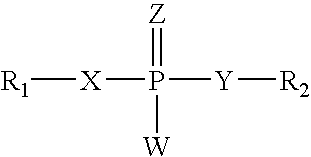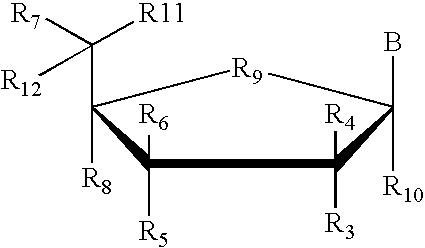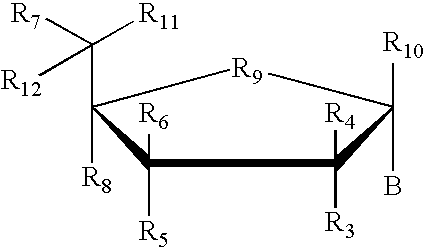Transcription factor RNA interference reagents and methods of use thereof
- Summary
- Abstract
- Description
- Claims
- Application Information
AI Technical Summary
Benefits of technology
Problems solved by technology
Method used
Image
Examples
example 1
Method of Selecting and Synthesizing the RNAI Regaents of the Present Invention
[0219] The sequence of the RNAi reagents of the present invention were chosen based upon the application of proprietary algorithms to the coding region of E2F1 target gene that incorporate both known rules and proprietary rules for designing such reagents. Identified RNAi reagents were cross-checked using BLAST searches against publicly available sequences databases to ensure each sequence was specific to the E2F1 target sequence. The efficacy of each RNAi reagent for inhibiting the expression of the E2F1 target sequence was assessed as outlined elsewhere herein.
[0220] Reagents E2F1-10, E2F1-12, E2F1-13, E2F1-14, and E2F1-15 were synthesized by QIAGEN (Valencia, Calif.) using proprietary TOM amidites at 20 nmol scale, in accordance with the methods outlined in the following U.S. Pat. No. 5,986,084; which is hereby incorporated by reference herein in its entirety.
[0221] Reagents E2F1-5, E2F1-6, E2F1-7, ...
example 2
Method of Transfecting Cultured Cells with the RNAI Reagents of the Present Invention
RNAi Transfection
[0223] RNAi transfection was done in 96 well plate. Briefly, Hela cells (ATCC) were seeded the day before the transfection at 26,000 cell / well in 125 ul of MEM media plus 10% of FBS. Before transfection, a dilution of the Lipofectamine™ 2000 (INVITROGEN) was prepared. From the stock tube, a 1:25 dilution in Opti-MEM was made. The mixture was allowed to stand at room temperature for about 15 minutes. At the same time, a dilution of the siRNA duplexes from the 20 uM stock tube was prepared. The dilution was further diluted in Opti-MEM to make a final concentration of 240 nM. After the lipid was diluted for 15 minutes, equal volumes of the diluted lipid and the diluted siRNA duplexes were mixed together and incubated at room temperature for 20 minutes to allow the siRNA and the lipid to form complexes. Then, 25 μl of the mixed solution was added to the appropriate wells, pipetted up ...
example 3
Method of Measuring the Effect of Transfecting Cultured Cells with the RNAI Reagents of the Present Invention on the Transcript Levels of each Target mRNA
mRNA Isolation
[0224] mRNA was isolated according to the manufacturers instructions for the mRNA Catcher™ Protocol from SEQUITUR (Natick, Mass.).
cDNA Synthesis
[0225] cDNA synthesis was performed by using a modified procedure outlined in the ABI TaqMan reverse transcription kit, No. N808-0234 from Applied Biosystems, Inc. (Foster City, Calif.). Briefly, the modified method was as follows: 19.25 ul of mRNA solution was used for cDNA synthesis. The reaction was performed in an ABI thermal cycler 9600 with one cycle as follows: 25° C., 10 min; 48° C., 40 min; and 95° C. for 5 min. The cDNA was keep at −20° C. until use.
Quantitative RT-PCR
[0226] Oligonucleotide primers and TaqMan® probes for the E2F1 gene for the quantitative PCR experiments were purchased from Taqman® Assays-on-Demand™ Gene Expression Products (Applied Biosystems ...
PUM
 Login to View More
Login to View More Abstract
Description
Claims
Application Information
 Login to View More
Login to View More - R&D
- Intellectual Property
- Life Sciences
- Materials
- Tech Scout
- Unparalleled Data Quality
- Higher Quality Content
- 60% Fewer Hallucinations
Browse by: Latest US Patents, China's latest patents, Technical Efficacy Thesaurus, Application Domain, Technology Topic, Popular Technical Reports.
© 2025 PatSnap. All rights reserved.Legal|Privacy policy|Modern Slavery Act Transparency Statement|Sitemap|About US| Contact US: help@patsnap.com



